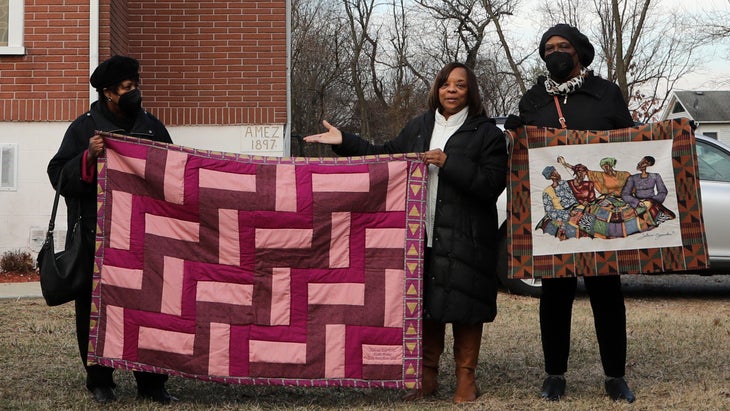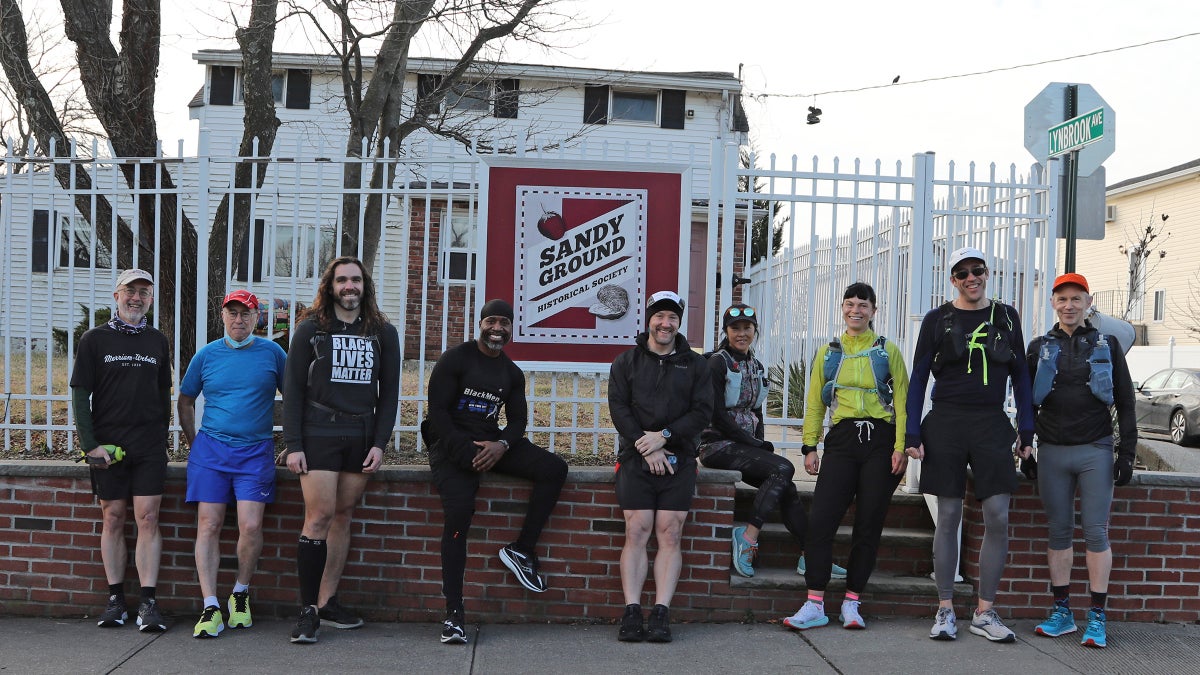No products in the cart.
Outdoor Adventure
An Ultramarathon Grapples with Slavery’s Legacy in New York
Receive $50 off an eligible $100 purchase at the Outside Shop, where you’ll find a selection of brand-name products curated by our gear editors, when you
sign up for Outside+ today.
Last Saturday in New York, several dozen runners took part in the inaugural NYC Black History 50. According to its website, the event was an interactive experience intended to “introduce runners to key moments and sights important to understanding Black history in New York City, whether the harsh realities of slavery, or the uplifting stories of free Black communities and empowerment that flourished then, and now.” The 53.9-mile route began in Sandy Ground in southern Staten Island, home of the first free Black community in New York, and culminated at the Apollo Theater in Harlem, a storied institution that has served as a nexus of Black culture for nearly 100 years.
While Sandy Ground and the Apollo are testaments to Black empowerment and resilience in New York, the idea behind the NYC Black History 50 is rooted in a much grimmer chapter in the city’s history. Todd Aydelotte is a self-described “historical ultrarunner” who has made a hobby out of high-mileage solo excursions throughout his city based on historical themes—like visiting every address where Edgar Allen Poe lived during his years in the city, or the myriad locations that played a role in the outsized life of Teddy Roosevelt. Although he considers himself something of an expert in local history, it was only a few years ago that Aydelotte, who is white, learned about an incident in 1741 where more than 100 Black slaves and several low-ranking white citizens were accused of conspiring against members of the city’s elite. This resulted in scores of executions, including 13 Black men who publicly were burned at the stake in what is now Foley Square in Lower Manhattan. According to historian Jill Lepore’s 2006 book, New York Burning, the incident was referred to as the “Bonfires of the Negros” at the time.
“It’s one of the worst atrocities ever swept under the carpet in New York’s history,” Aydelotte says. “And hardly anyone knows about this. It’s unbelievable that that happened.”
After learning about Foley Square, Aydelotte conceived of an ultra that would attempt to reckon with this aspect of New York’s past—one that belied the city’s self-image as being on the “right side of history.” (Much of modern New York was built by slave labor; in the mid-18th century the city had the largest percentage of slave owners in the country after Charleston, South Carolina. And although slavery was officially abolished in New York in 1827, the city would continue to profit off the international slave trade for years.) In February 2019, Aydelotte ran a 40-mile route that traversed all five boroughs and featured many of the stops included in last weekend’s Black History 50. After his effort got some local news coverage, Aydelotte was contacted by members of the local Black running community, including the groups Black Men Run and Harlem Run. They liked the idea, but felt the concept could be expanded to include other sites in the city that were largely unknown to many residents. The NYC Black History 50 emerged as a collaborative effort intended to highlight overlooked places of significance. In the neighborhood of East New York, for instance, an obliterated 19th-century African burial ground sits adjacent to a well-maintained graveyard where the remains of several slave-owning families lie interred. It’s hard to think of a more blatant illustration of how some histories are remembered while others are literally covered up.
For Alison Désir, the founder of Harlem Run and the author of the forthcoming book Running While Black, this speaks to a broader trend of a kind of willful amnesia—one that an event like the Black History 50 might help to remedy. “One thing that Black and marginalized folks know is that our history is often intentionally overlooked and left out of textbooks, or history that makes white people uncomfortable is not told,” Désir says. “This run was exactly everything that our group is about. It’s about celebrating Black folks, people of color, so that’s what got me excited about it.”

Désir’s organization curated the Harlem section of the run, which included a visit to the Harriet Tubman Memorial, a bronze statue of the famous abolitionist and Underground Railroad operator. Located just a few blocks from the Apollo, the Tubman statue feels like an especially apropos stop for the finale of an ultra. As Désir puts it: “Harriet Tubman was an ultramarathoner, crossing vast distances to take people from slavery to a different future.”
The metaphorical aspect of staging a Black history tour as an ultra also wasn’t lost on Brandon Jackson, a captain of the New York City chapter of Black Men Run and one of five people who ran the entire route last Saturday. (Jackson and Aydelotte had to hop in an Uber for approximately three miles in Staten Island to make sure they wouldn’t miss the ferry to Manhattan. So technically they only ran 50 miles of the 53.9-mile route, but don’t hold it against them.) “The distance is something that is extraordinary,” Jackson said last week as he was gearing up for the effort. “It’s not going to be easy, but the situation that we are engaging with wasn’t an easy time for people of color. I’m just interested in being a part of it. These locations have been in my backyard my whole life and I have very little knowledge of most of it.”
Exposing some of the more ignominious chapters of the past can be a fraught enterprise. But one of the animating ideas behind the Black History 50 is that, however painful it may be to acknowledge historical atrocities, in the long run it’s always more costly to look away. Like it or not, this stuff happened here. “The reason why we know our history is not to shame or guilt anyone, but because it is a fact and something that can inform your worldview,” Désir says. “I think that what we do when we hide the truth is we then create more shame around it.”
In the words of percussionist and scholar Chief Baba Neil Clarke, who on Saturday held a libation ceremony in Foley Square for those executed at the same spot 281 years ago: “We cannot in all honesty hope to look forward for ourselves and for our children to enjoying the warmth and beauty of the sunshine in our collective futures if we are not prepared to take a cold, hard look today into the ugliness that are the skeletons that inhabit our collective history closet of this country. Those skeletons, unacknowledged—specters if you will—will always be there to raise their mangled heads when we least desire or can afford.”

